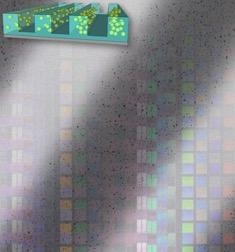Mar 14 2017
Controlling the organization of nanoparticles into patterns in ultrathin polymer films can be accomplished with entropy instead of chemistry, according to a discovery by Dr. Alamgir Karim, UA’s Goodyear Tire and Rubber Company Professor of Polymer Engineering, and his student Dr. Ren Zhang. Polymer thin films are used in a variety of technological applications, for example paints, lubricants, and adhesives. Karim and Zhang have developed an original method—soft-confinement pattern-induced nanoparticle segregation (SCPINS) — to fabricate polymer nanocomposite thin films with well-controlled nanoparticle organization on a submicron scale. This new method uniquely controls the organization of any kind of nanoparticles into patterns in those films, which may be useful for applications involving sensors, nanowire circuitry or diffraction gratings, with proper subsequent processing steps like thermal or UV sintering, that are likely required but the self-organization into directed patterns. This work, "Entropy-driven segregation of polymer-grafted nanoparticles under confinement," has been published in the February 2017 issue of Proceedings of the National Academy of Sciences (PNAS).
 This is an illustration of ordered nanoparticle organization induced by the novel method (SCPINS). It is applicable to different pattern geometries and particle compositions. The background electric-circuit model pattern is shown as an example. (Credit: The University of Akron)
This is an illustration of ordered nanoparticle organization induced by the novel method (SCPINS). It is applicable to different pattern geometries and particle compositions. The background electric-circuit model pattern is shown as an example. (Credit: The University of Akron)
Intuitively, entropy is associated with disorder of a system. However, for colloidal matter, it has been shown that a system can experience transitions which increase both entropy and visible order. Inspired by this observation, Karim and Zhang investigated the role of entropy in directed organization of polymer-grafted nanoparticles (PGNPs) in polymer thin films. By simply imprinting the blend films into patterned mesa-trench regions, nanoparticles are spontaneously enriched within mesas, forming patterned microdomain structures which coincide with the topographic pattern. This selective segregation of PGNPs is induced by entropic penalty due to the alteration of the grafted chain conformation when confined in ultrathin trench regions.
For the first time, the desired spatial organization of nanoparticles is achieved by topographic pattern-induced entropic confinement effect, without tuning enthalpic interactions through chemistry. This facile method, SCPINS, is applicable to versatile particle compositions and pattern geometries. This work can be extended to multicomponent particle systems, which has potential applications in nanomaterial-based technologies such as nanoelectronics and plasmonics.
“The process is highly efficient as it can incorporate all the nanoparticles without wastage in the remaining matrix film upon patterning --100% of the nanoparticles are patterned,” explains Karim. “The remnant matrix can be rinsed way with no loss of expensive nanoparticles.”
This research was performed in collaboration with National Institute of Standards and Technology (Dr. C. M. Stafford and Dr. J. F. Douglas) and Carnegie Mellon University's College of Engineering. The collaboration included CMU Professor of Materials Science and Engineering Michael Bockstaller and his research group, who have research interests in polymer-based nanostructures and polymer-based nanoparticle assemblies. The group focused on the synthesis of the polymer-tethered nanoparticles that were used in the study.
Read the full article in PNAS, 2017, doi:10.1073/pnas.1613828114.